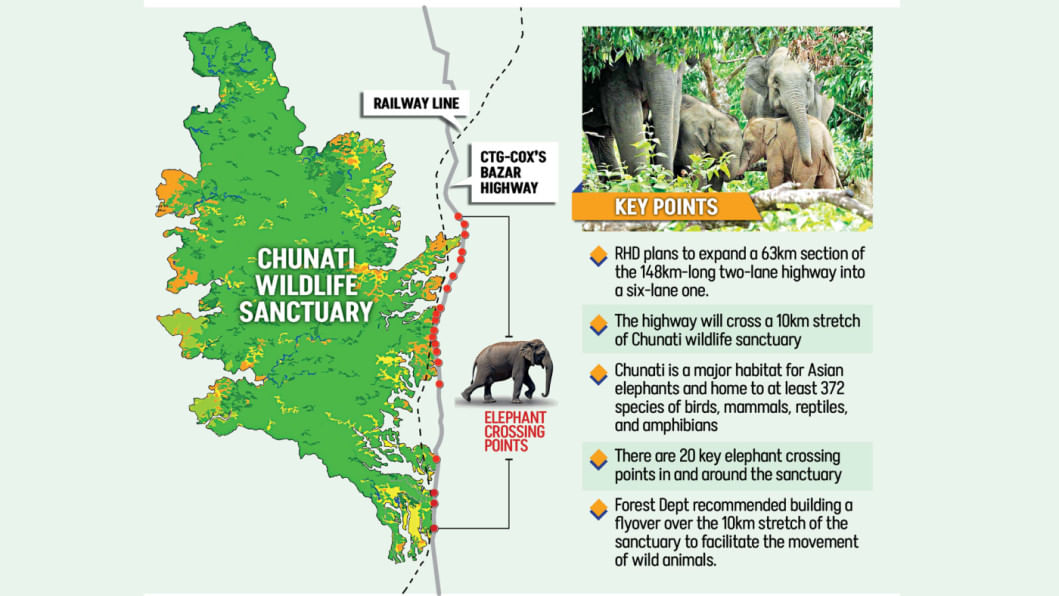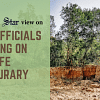Ctg-Cox’s Bazar highway: Expansion to put wildlife in peril

The Roads and Highways Department's move to expand the Chattogram-Cox's Bazar highway running through the Chunati Wildlife Sanctuary could spell disaster for wildlife habitats and disrupt several key elephant corridors in the ecologically sensitive area, warn forest officials and environmentalists.
RHD plans to expand a 63km section of the 148km-long two-lane highway into a six-lane one. Wild animals are already in danger of being struck by vehicles, as well as trains running on Dohazari-Cox's Bazar route, while crossing a 10km stretch of the sanctuary, according to forest officials.
"If the highway becomes wider, it will be nearly impossible for wild animals to cross the stretch… We strongly oppose any road expansion that will further endanger the sanctuary. It cannot withstand another blow in the name of development," said Abu Naser Mohammad Yasin Newaz, divisional forest officer of Chattogram Wildlife Division.
Chunati, a major habitat for Asian elephants in southeastern Bangladesh, is home to at least 372 species of birds, mammals, reptiles, and amphibians, according to a 2022 biodiversity assessment by conservation groups Nishorgo and Arannayk Foundation.
Among them are several endangered species such as hoolock gibbon, leopard cat, and Asian black bear.
The forest area, spanning 7,764 hectares of land between Chattogram and Cox's Bazar, was declared a sanctuary in 1986.
On July 23 this year, RHD wrote to the Forest Department, seeking its opinion on the road expansion plan.
"If the highway becomes wider, it will be nearly impossible for wild animals to cross the stretch."
RHD maintained that the project is necessary to cope with the rising passenger and freight traffic in the region and to reap the full benefit of Matarbari Deep Sea Port, scheduled to begin operations in 2030.
In its reply to RHD, the Forest Department warned that the project would significantly increase the risk of roadkill or wild animal-vehicle collisions and cause permanent harm to wildlife habitats.
"If the highway is expanded, elephants and other wildlife will need more time to cross it. In the future, an increased volume of traffic will further obstruct the movement of wild animals, resulting in habitat fragmentation and disruption to their natural way of life," it said in a letter to RHD on August 25 this year.
The letter also referred to the recently built Chattogram-Cox's Bazar railway line, 10km of which cuts through the sanctuary, and said that Asian elephants and other wild animals are already at risk of being hit by trains while crossing the track.
The Forest Department recommended that RHD build a flyover over the 10km stretch of the sanctuary to facilitate increased vehicular traffic, avoiding further disruption to the movement of wild animals.
It also identified 20 key elephant crossing points in and around the sanctuary and suggested construction of additional overpasses and underpasses to facilitate their safe movement.
However, RHD officials said the construction of a 10km-long flyover would substantially raise the project cost, estimated at Tk 21,754 crore in 2023.
Jahid Hossain, superintendent engineer of the RHD Chattogram Circle, said it is not financially viable to build such a structure.
"Nevertheless, we are in favour of building a 700-metre-long flyover from Jangalia to Satgarh within the sanctuary, along with several underpasses and overpasses at key locations," he said.
Last year, RHD signed a memorandum of understanding with Japan International Cooperation Agency (JICA) to conduct a survey on the highway's expansion from Shikalbaha in Chattogram to the bridge over Matamuhuri River in Cox's Bazar.
When contacted, Bashir Ahmed, a member of the JICA survey team, said, "The one-year survey, launched in October last year, is scheduled to be completed this month. However, that won't be possible as the stakeholders -- RHD, the Forest Department and JICA -- are yet to reach a consensus on the proposed Chattogram-Cox's Bazar Highway Improvement Project (Phase-2)."
He hoped that the survey will be completed by December this year.
WHAT EXPERTS SAY
Experts warn that if the highway expansion project is implemented, it could severely obstruct elephant movement across three major corridors, including the Chunati–Satgarh route.
Sanjida Rahman, an environmental activist and coordinator of Chunati Rokkhay Amra, said the highway's expansion would jeopardise the elephant corridors.
She urged the RHD to consider constructing a flyover for the 10-km stretch of the sanctuary or upgrading the Chattogram-Banshkhali-Pekua road as an alternative route for better connectivity between Matarbari Port, Cox's Bazar, and Chattogram.
MA Aziz, professor of Zoology at Jahangirnagar University, said government agencies in Bangladesh often cite financial constraints as a justification for neglecting conservation priorities. But budgetary concerns cannot be used as an excuse when it comes to protection of critical elephant corridors.
"Development must be balanced with ecological responsibility. Government agencies must not be allowed to construct roads that would inflict irreversible damage on protected forest ecosystems," noted Aziz, also a member of Asian Elephant Specialist Group of the IUCN, a global organisation working in the field of nature conservation and sustainable use of natural resources.
THE RAILWAY LINE
There was an outcry from conservationists in October last year after an elephant was killed by a train operating on the Chattogram-Cox's Bazar rail line that went into service on December 1, 2023.
They pointed out a lack of safeguards for elephants and other wild animals in the sanctuary.
Forest officials said that when Bangladesh Railway took up the project, it had pledged to construct "sufficient" overpasses and underpasses for elephants to safely cross a 10km stretch of the 103km rail line from Dohazari to Cox's Bazar. But only three such structures were built, with one of them unusable because of design flaws.
To facilitate the project, the government in 2018 revoked the protected status of 207 acres of forestland. Later, around 240,000 trees were felled, and several hills were razed, according to Wildlife Division data.

 For all latest news, follow The Daily Star's Google News channel.
For all latest news, follow The Daily Star's Google News channel. 






Comments